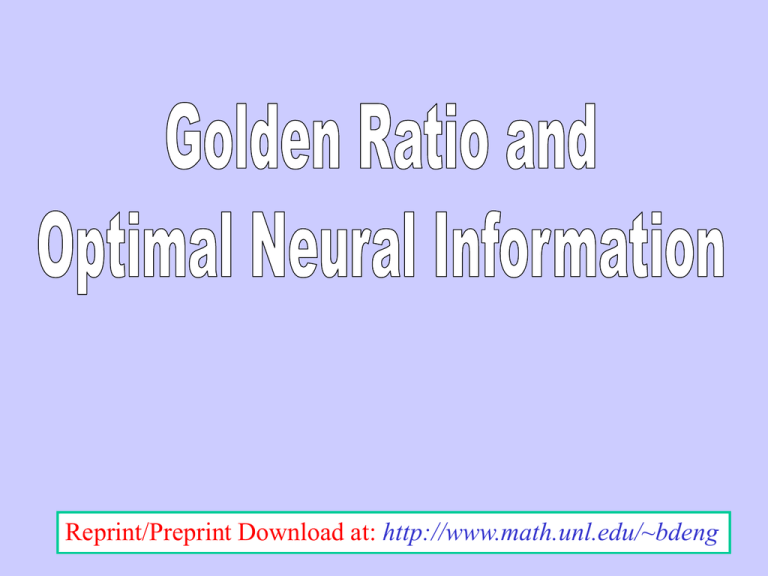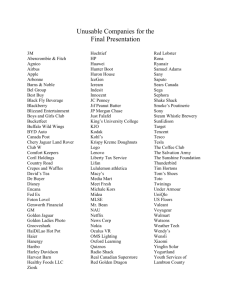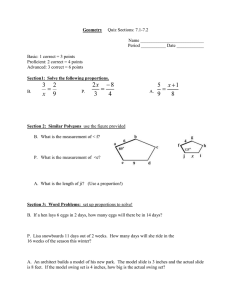Title Reprint/Preprint Download at:
advertisement

Reprint/Preprint Download at: http://www.math.unl.edu/~bdeng
Title
Golden Ratio f :
1
f
f + f2 = 1
f=
5 1
0.6180...
2
f2
• Pythagoreans (570 – 500 B.C.) were the first to know
that the Golden Ratio is an irrational number.
• Euclid (300 B.C.) gave it a first clear definition as
‘ the extreme and mean ratio’.
1
f2
f3
f
• Pacioli’s book ‘The Divine Proportion’ popularized
the Golden Ratio outside the math community (1445 – 1517).
• Kepler (1571 – 1630) discovered the fact that
Fn 1 Fn f, Fn the nth Fibonacci number.
• Jacques Bernoulli (1654 – 1705) made the connection
between the logarithmic spiral and the golden rectangle.
• Binet Formula (1786 – 1856)
1 / f f
n
n
Fn
5
• Ohm (1835) was the first to use the term
‘Golden Section’.
Nature
Neurons Models
Rinzel & Wang (1997)
Bechtereva & Abdullaev (2000)
1
time
3T
Neurons
1T
(1994)
seedtuning
SEED Implementation
Spike Excitation Encoding & Decoding(SEED)
3 2 4 3 3 2 2 11 3 …
Encode
Signal
Channel
Decode
Mistuned
Information System
Alphabet:
A =if{0,1}
In general,
A = {0, …, n-1}, P({0}) = p0 ,…, P({n –1}) = pn –1,
Message:
11100101…
then eachs =
average
symbol contains
Information System:
Ensemble
messages,
E(p) = (–
p0 ln p0 –of…
– pn –1 ln characterized
pn –1 ) / ln 2 by
probabilities:
bits of information, symbol
call it the
entropy. P({0})= p0 , P( {1})= p1
Example:
Probability
for a particular message s0… sn –1 is
1},
equal #probability
P({0})=P({1})=0.5.
# of
1s w/
ps … psAlphabet:
= p0# ofA0s=p{0,
,
where
of
0s
+
#
of
1s = n
1
Message:
…011100101…
0
n
The average
symbol
for a typical message is
Then
each probability
alphabet contains
p0 p1
(#
of
0s)
/
n
(#
of
1s)
/
n
1/n
E
=
ln
2
/
ln
2
=
1
bit
(ps … ps ) = p0
p1
~ p0 p1
0
n information
of
Entropy
log ½ p
-ln p / ln 2
log ½ p
-ln p / ln 2
0
0
,
1
Let p0 = (1/2)
= (1/2)
p1 = (1/2)
= (1/2) 1
Then the average symbol probability for a typical message is
(– p ln p – p ln p ) / ln 2
E( p )
p0 p1
1/n
0
0
1
1
:
(ps … ps ) ~ p0 p1 = (1/2)
= (1/2) 0
0
n
By definition, the entropy of the system is
E(p) = (– p0ln p0 – p1ln p1) / ln 2 in bits per symbol
Entropy
Bit rate
Golden Ratio Distribution
Bit rate
SEED Encoding:
Sensory Input Alphabet: Sn = {A1 , A2 , … , An } with probabilities {p1, …, pn}.
Isospike Encoding: En = {burst of 1 isospike, … , burst of n
isospikes}
Message: SEED isospike trains…
Idea Situation: 1) Each spike takes up the same amount of time, T,
2) Zero inter-spike transition
Then, the average time per symbol is
Tave (p) = Tp1 + 2Tp2+… +nTpn
And, The bit per unit time is
rn (p) = E (p) / Tave (p)
time
3T
Theorem: (Golden Ratio Distribution) For each n r 2
1T
8
rn* = max{rn (p) | p1 + p2+… +pn = 1, pk r 0} = _ ln p1 / (T ln 2)
for which pk = p1k and p1 + p12 +… + p1n = 1.
In particular, for n = 2, p1 = f, p2 = f 2 .
In addition, p1(n) ½ as n .
Golden Ratio Distribution
Bit rate
Generalized Golden Ratio Distribution = Special Case:
Tk = m k, Tk / T1 = k
Golden Sequence
(Rule: 110, 01)
1
10
101
10110
10110101
1011010110110
101101011011010110101
# of 1s
(Fn)
1
1
2
3
5
8
13
# of 0s
(Fn-1)
Total
(Fn + Fn –1 = Fn +1)
0
1
1
2 tile} f
P{fat
3 tile} f2
P{thin
5
8
(# of 1s)/(# of 0s) = Fn /Fn-1 1/f, Fn+1 = Fn + Fn -1,
> Distribution: 1 = Fn /Fn+1 + Fn -1 /Fn+1 , > p1 f , p0 f 2
Title





